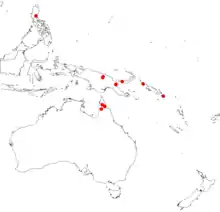Cecarria
Cecarria is a monotypic genus in the family Loranthaceae. The sole species is Cecarria obtusifolia, a hemiparasitic aerial shrub.[1]
| Cecarria | |
|---|---|
| Scientific classification | |
| Kingdom: | Plantae |
| Clade: | Tracheophytes |
| Clade: | Angiosperms |
| Clade: | Eudicots |
| Order: | Santalales |
| Family: | Loranthaceae |
| Genus: | Cecarria Barlow |
| Species: | C. obtusifolia |
| Binomial name | |
| Cecarria obtusifolia | |
 | |
| Occurrence data from GBIF | |
| Synonyms[1] | |
| |
Description
Cecarria obtusifolia is an aerial, stem-parasitic shrub, and like species in the genus Muellerina, it has epicortical runners.[3] It is glabrous throughout.[4] The obovate or broadly obovate[3] leaves are opposite, curvinerved, and rounded at the apex.[3] The leaf blades are 30–55 mm long and 20–45 mm wide, and attenuate into an obscure petiole 2–6 mm long.[5] The inflorescence is axillary, with and a two-flowered umbel or a four-flowered raceme or spike; there are nearly orbicular bracts[5] beneath each flower.[3] The flower has six free petals. The stamens are nearly equal, and the anthers are dorsifixed and versatile,[3] having a short sterile tip with the free part of the filament about 2 mm long.[5]
The peduncle is 6–9 mm long and up to 20 mm when the inflorescence is a raceme. The flowers are sessile or on pedicels up to 3 mm long. The calyx is entire and 0.5–1 mm long. The ivory-white corolla in mature bud is 10–14 mm long and slightly club-shaped. The fruit is almost spherical and about 8 mm long.[5]
Distribution and habitat
Cecarria obtusifolia occurs in the Philippines, New Guinea, the Solomon Islands, and in Cape York Peninsula, Queensland, Australia,[3] and also in the Lesser Sunda Islands and Bougainville (New Guinea).[6] The genus is thought to be a relictual Gondwanan entity.[3]
In Australia it occurs in the McIlwraith Range area in Queensland, growing in rainforest. Recorded hosts include plants in the genera: Calophyllum, Casuarina,[7] and Syzygium, and Xanthostemon.[5][7]
Taxonomy
The species was first described by Elmer Drew Merrill as Phrygilanthus obtusifolius in 1906.[5][4] In 1973, Bryan Barlow redescribed it, assigning it to the new genus, Cecarria, and the name thus became C. obtusifolia.[1][2] The current accepted description is that of Barlow in 1984.[1][8]
The genus Cecarria is named for Cedric Errol Carr (1892–1936).[3] The leaves, which are blunt and rounded at the apex (tip), gave rise to the latin-derived name, obtusifolia, meaning "obtuse-leaved".[9]
Conservation
It is considered to be "Not Threatened" (NT) in Queensland under the Nature Conservation Act 1992 of Queensland.[10]
References
- "Cecarria obtusifolia". Australian Plant Name Index (APNI), IBIS database. Centre for Plant Biodiversity Research, Australian Government. Retrieved 21 November 2018.
- Barlow, B. A.; Wiens, D. (1973). "The Classification of the Generic Segregates of Phrygilanthus (=Notanthera of the Loranthaceae". Brittonia. 25 (1): 26. doi:10.2307/2805488. ISSN 0007-196X.
- Barlow, B.A. (1984) Cecarria . Flora of Australia Online. Department of the Environment and Heritage, Australian Government. Retrieved 21 November 2018.
- Merrill, E.D. (1906), Philippine Journal of Science 1 (Suppl.): 189
- Barlow, B.A. (1984) "Cecarria obtusifolia(Merr.) Barlow". Flora of Australia Online. Department of the Environment and Heritage, Australian Government.
- Cecarria obtusifolia GBIF.org (28 December 2018) GBIF Occurrence Download https://doi.org/10.15468/dl.dbpsoy
- Nickrent, D. The Parasitic Plant Connection: Cecarria obtusifolia. Department of Plant Biology, Southern Illinois University, Carbondale. Retrieved 21 November 2018.
- Barlow, B.A. (1984) in George, A.S. (ed) Loranthaceae, Flora of Australia Volume 22 Rhizophorales to Celastrales (pp.90-91, Fig. 23E-F, Map 103). Commonwealth of Australia, Canberra.
- Stearn, W.T. (1992) Botanical Latin (4th ed) p.414, p.455. Timber Press, Oregon. Retrieved 21 November 2018.
- Rare or threatened plants of Queensland Queensland Government, Department of Environment and Science. Retrieved 21 November 2018.
External links
- Australasian Virtual Herbarium: Occurrence data for Cecarria obtusifolia
- Illustration of Cecarria obtusifolia (Merr.) Barlow. www.botanicalillustrations.org
- GBIF:Occurrence data and images for Cecarria obtusifolia
- Google images: Cecarria obtusifolia
- Australian Rainforest Plants: Cecarria obtusifolia
- Flora Malesiana: Cecarria obtusifolia